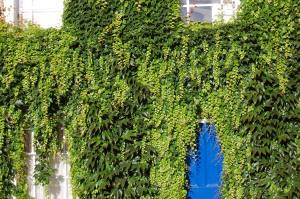
Parthenocissus tricuspidata leaf (10/08/2011, London)
Position: Full sun, partial shade and full shade
Soil: well drained soil
Flowering period: Summer
Eventual Height: 12m
Eventual Spread: N/A
Hardiness: USDA Zone 4a-8b
Family: Vitaceae
Parthenocissus tricuspidata is a deciduous shrub with a climbing habit. Its woody branches attach to its support structure by way of branched tendrils that have holdfasts. Its glossy foliage is mid to dark green, measuring between 5cm – 22cm across, this becomes a deep crimson in autumn. Its insignificant flowers are small and greenish in colour. These are followed by small bluish-black round fruits.
P. tricuspidata, commonly known as Boston Ivy, Grape Ivy, Japanese Ivy or Japanese Creeper, is native to Eastern Asia including China, Japan and Korea. It is also widely naturalised in many temperate climates, including the UK. This plant clings by means of secreting calcium carbonate through its adhesive pads, giving it the ability to cling without the need for support. This plant will not damage masonry if left alone, however if the plant is ripped from the building damage may occur. If the plant is first killed by severing the stem the adhesive pads will deteriorate and allow the plant to be removed easily.
Parthenocissus is derived from the Greek parthenos meaning ‘virgin’ and kissos meaning ‘ivy’, with tricuspidata being a Latinised word meaning ‘three pointed’ in reference to its foliage.

Parthenocissus tricuspidata (10/08/2011, London)
This plant may be useful to the landscape architect in a vigorous deciduous climber with the changing of leaf colour providing autumn interest. It can be used in warmer climates to reduce comfort cooling costs in buildings by shading their exterior walls, reducing solar gain.
The Royal Horticultural Society gave this plant their prestigious Award of Garden Merit in 1993.
This plant will tolerate almost any soil conditions; it will be happy at neutral, acid or alkaline pH levels, in loam, chalk, clay or sand based soils, facing any sheltered or exposed aspect.
Ecologically this plant will attract many species of pollinating insects such as honey bees and butterflies. It will also attract various species of birds which will feed on its fruit and shelter from predators in its foliage.
Maintenance: This plant requires little to no maintenance. It may be pruned in winter or if required in summer to restrain its growth in unwanted areas.
Eco World Content From Across The Internet.
- More
- StumbleUpon
- Digg

